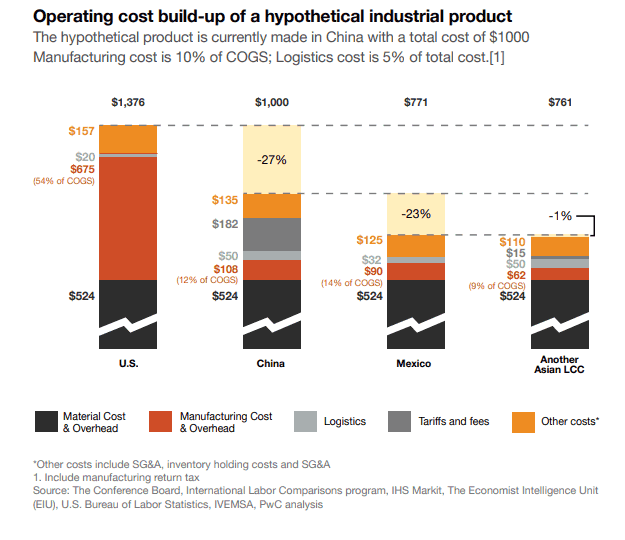Leaving China from a sourcing perspective isn’t the right move for all companies, but for some, the savings potential and added resilience such a change would bring may look very enticing indeed.
That according to a new report from PwC, which says that "The COVID-19 pandemic is casting in stark relief vulnerabilities of global footprints that have been developing for several years."
Supply Chain Digest Says... |
 |
| PwC says its analysis shows that, for US manufacturers, adopting a dual strategy of adding Mexico as the "plus 1" can actually be more cost efficient than a pure China play. |
 |
What do you say? |
| Click here to send us your comments |
| |
| Click here to see reader feedback |
|
|
There are many challenges to leaving China, especially for manufacture of sophisticated products, the report notes. Those barriers include the prospects of leaving supplier networks developed over decades, and replacing China’s well-developed transportation infrastructure, logistics, production capacity and scale.
Making in China might also be key to tapping into the huge China domestic market.
But for companies that can shift production from China operating costs could be reduced, on average, by 23% if they near-shored to Mexico, and by 24% if they shifted to another Asian low cost country (LCC).
In addition, PwC says that "We believe such alternatives would – on top of these cost savings – also add resiliency and improve customer experience."
There is also a middle-ground, the so-called "China + 1" strategy of keeping say half of sourcing in China but moving the rest to a single other nation, which might cut costs and provide regional diversification and less political risk than an all China model.
In fact, PwC believes we are at the start of a true inflection point away from China, towards a "global supply chain rebalancing with a desire, as well as a business imperative, toward resilience, agility and localization needs."
Numerous factors are driving this strategic change, including rising labor and logistics costs in China, new tariffs and trade policies, and the growing need to be more responsive to meet regional and customer-centric demand, PwC says.
At the same time, other Asian countries have upped their games and become more competitive with China. PwC also notes that for North American manufacturers, Mexico is increasingly positioned as an attractive option to China, especially for US market sales, given the new USMCA that went into effect on July 1.
The PwC report includes a cost model for manufacturing a hypothetical product in China, the US, Mexico and a lost cost Asian country. As seen in the graphic below, the China made product has a total baseline cost of $1000.

US costs are a much higher, at $1376 – but Mexico and another Asian country have costs 23% and 24% lower, respectively, versus that incurred in China.
(See More Below
|
CATEGORY SPONSOR: SOFTEON |
|
|
|
|
|
Supply Chain Resiliency Can Be Cost-Efficient
It is logical to think that the more resilient a supply chain is, the greater costs it carries. A manufacturer, for instance, might choose to hedge bets by opening a dual producer or supplier, which lowers volume at the origial source or might require production in a higher cost country.
However, PwC says its analysis shows that, for US manufacturers, adopting a dual strategy of adding Mexico as the "plus 1" can actually be more cost efficient than a pure China play.
"So, manufacturers diversifying from a single China source to a China + Mexico or a China + Another LCC model can trim costs, add flexibility and respond to customer demand more adroitly and swiftly," the report argues.
Of course there are many factors that must be weighed for such a change, often requiring sophisticated analysis to sort it all, and many companies will find standing pat is the best decision.
But PwC believes the pivot point is upon us, and many companies will significantly reduce their dependence on China soon.
Any reaction to PwC's market analysis? Let us know your thoughts at the Feedback section below.
Your Comments/Feedback
|

